An in-depth look at GHG trends in Non-Annex I countries ahead of COP-26
Get this executive brief in pdf format
Climate change and mitigation challenges are often presented under the prism of developed countries. However, Non-Annex I1countries contribute to a growing share of global GHG emissions and have been playing an active role in the publication of NDCs and revised ambitions. In this context, what are the main contributions and specific issues that Non-Annex I countries have to face in terms of mitigation? To which extent can they contribute to the transition towards a decarbonised word and the achievement of the +2°C Paris Agreement’s global objective? What is the current status of their contributions and what can be expected for the COP-26?
Introduction
In December 2015, the Paris Agreement was adopted and set a worldwide common goal to limit temperature increase to +2/1.5°C. The signatory parties committed to publish intended “nationally determined contributions” (NDCs) in fight against climate change. As of 2021, 191 members of the UNFCCC (from 197*) have ratified the agreement. The COP-26, which will take place this year, is an awaited moment as it is the first planned 5-year revision of NDCs and could therefore be the opportunity to strengthen climate commitments, especially in a context where current NDCs have been assessed as insufficient to reach the 2°C target. Countries are progressively publishing their 2nd NDC. Yet, this step towards a global response to climate change is often discussed under the prism of mitigation commitments from “developed” countries (with the exception of China). The role of Non-Annex I countries in issues related to GHG emissions is often underestimated, and the efforts and challenges they have to face with are quite specific but will be central in the transition towards a decarbonised world.
GHG global emissions (incl. LULUCF2): the underestimated contribution and multiple challenges in Non-Annex I countries
Six Non-Annex I countries today represent more than 40% of worldwide GHG emissions
As of 2017, around 2/3 of global GHG emissions arise from Non-Annex I countries, vs 45% in 1990. In total, worldwide GHG emissions including LULUCF reached around 49 Gtoe.
43% of GHG global emissions arise from 6 main Non-Annex I countries (vs 30% in 2000): China, India, Russia, Brazil, Indonesia and Iran.
Top contributor to global emissions is by far China with 26% of the total (vs 13% in 2000); only 9 further countries/regions have a contribution higher than 2%, of which 5 Non-Annex I countries with a total weight of around 17%.
Figure 1: GHG emissions (incl. LULUCF), 2017: 48.8 GtCO2e
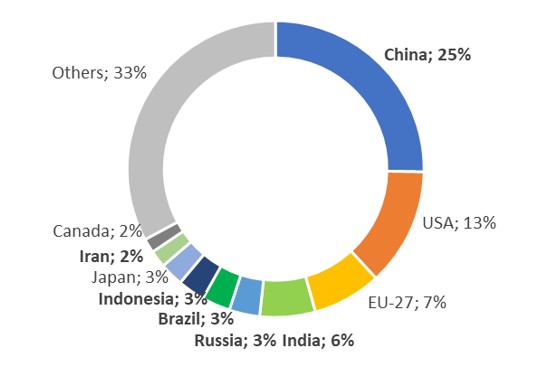
Source: FAO, PIK/PRIMAP
CO2 is still representing 75% of GHG global emissions, and nearly 2/3 of these CO2 emissions arise from Non-Annex I countries (as of 2017).
However, the share of Non-Annex I countries in CH4 and N2O emissions is much higher, with respectively nearly 80% and more than 90%. This reflects among other the larger contribution of the LULUCF, agriculture and waste sectors in Non-Annex I countries.
The challenge of decarbonisation for fast-growing economies
Since 1990, GHG emissions in Non-Annex I countries have increase by 2.8%/year on average, showing an accelerating trend since 2000: +3.3%/year.
Despite a significant economic growth (+1.9%/year on average over 2000-2017), GHG emissions have continued to increase at an even faster rate, leading to a growing carbon intensity over the period. The decoupling of economic growth and emissions (as well as energy consumption) is therefore a crucial issue for these countries. Non-Annex I countries still rely heavily on carbon-intensive energies, with 2/3 of their primary energy mix arising from coal (34%) and oil (31%, 2017), and past trend hardly shows improvement (oil 37%, coal 26% as of 2000).
When looking at sectoral emissions, it appears that the main emitting sectors of Non-Annex I countries remain by far fuel combustion activities (58% in 2017), followed by agriculture (14%). Excluding China, the share of emissions from fuel combustion activities amount to 49%; when agriculture and LULUCF contribute to about 1/3 (with respectively 17% and 15%).
Figure 2: Evolution of GHG emissions in Non-Annex I countries, by sector (2017)
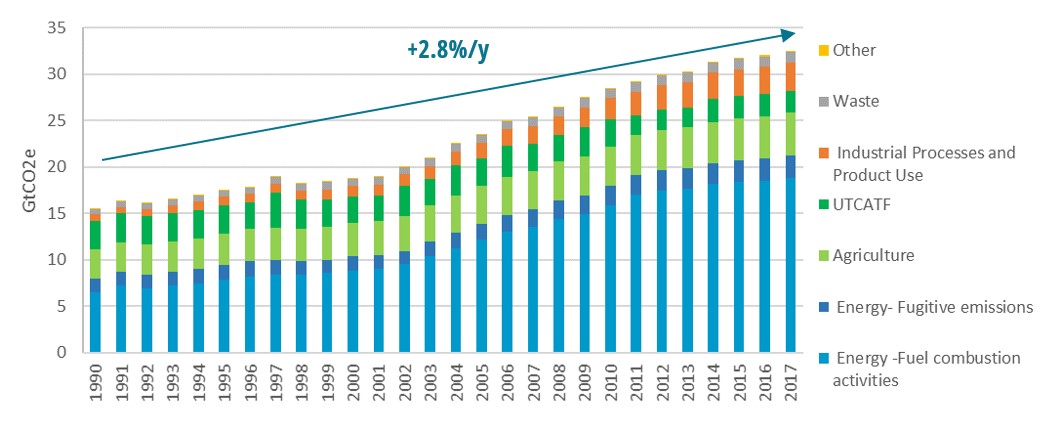
Source: FAO, PIK/PRIMAP
CO2 emissions from the power sector represent 47% of emissions from fuel combustion in Non-Annex I countries (+ 9 points comp. to 2000). A shift towards low-carbon electricity is a prerequisite for these countries to reach the Paris agreement. This is all the most a challenge as many of Non-Annex I countries still have to ensure a universal access to electricity to their populations. Thus, electricity consumption in Non-Annex I countries is expected to increase by 36% by 2030. Yet since 2000, around 2520 GW of power capacities have been installed in Non-Annex I countries, of which 44% of coal-fired power plants and 17% of gas-fired power plants. (resp. 24% and 38% if excl. China). As of 2019, 48% of the power production arises from coal in Non-Annex I countries.
Figure 3: Evolution of electricity consumption in Non-Annex I countries until 2030
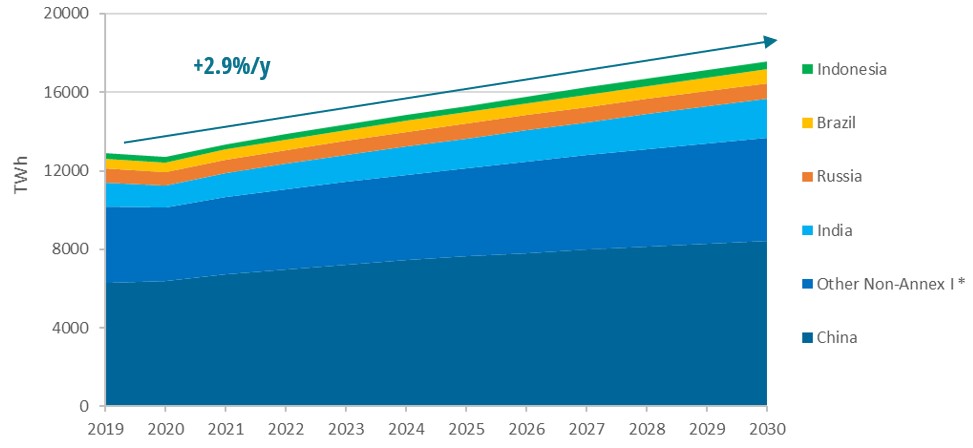
* Non-Annex I: modelling perimeter excluding Colombia and Israel, including Belarus, Liechtenstein and Monaco
Source: Enerdata, EnerGreen scenario (scenario compatible with the +2°C target)
The LULUCF sector at the non-Annex I level is a large emitting sector, despite contrasted situations among countries: China and Russia are the two largest carbon sinks worldwide (total of about 1.2 GtCO2e, 2017), but the emissions thus captured are offset by the emissions from the LULUCF sectors of the Democratic Republic of the Congo and Indonesia, which are both the two biggest global emitters as regards LULUCF emissions.
The LULUCF sector is a natural sink. It is a central component for both mitigation and adaptation strategies in many Non-Annex I countries’ NDCs; the past and current trends however show that a sustainable management of forest and agriculture lands will be necessary to benefit from the carbon sinks potential. The topic is all the most important as biomass still represent a significant share of Non-Annex I countries’ energy mix (12% as of 2017, 17% excl. China).
Among Non-Annex I countries, there is however a great diversity of contexts, which led to different priorities and ambitions in terms of mitigation.
Non-Annex I countries and NDC mitigation ambitions- specificities and contributions to the global effort
Emissions reduction in NDCs: disparity in targets and ambitions
Different types of targets were set in first NDCs of both Annex I and Non-Annex I countries. The majority of targets defined by Non-Annex I countries are baseline-based, i.e. the goal is defined as a reduction compared to a “baseline” scenario for a given horizon (mostly 2030). This type of target gives a crucial role to robust forecasts and transparency in chosen assumptions. A few countries implement ratio targets, such as China (” lower carbon dioxide emissions per unit of GDP by 60% to 65% from the 2005 level”) and India (“reducing the emissions intensity of GDP by 20–25%, over 2005 levels, by 2020”).
Most of these countries have an “economy-wide” approach for their target, i.e. a clear contribution by sector to the national emission reduction is still to be clearly defined.
Figure 4: NDCs and types of targets worldwide

Source: PBL
Within Non-Annex I countries, there are indeed various profiles regarding sectoral contribution to national emissions, besides the key features previously identified (growing economy leading to growing energy needs and emissions, electrification trend, weight of the agriculture and LULUCF sectors compared to Annex I countries).
The below overview underlines this diversity: around 40% of national emissions arise from the agriculture sector in Brazil, and from LULUCF in Nigeria; similar to many Annex-I countries, the power sector is a large contributor to emissions in India (35%).
Figure 5: Total GHG emissions by sectors, selection of Non-Annex I countries (2017)
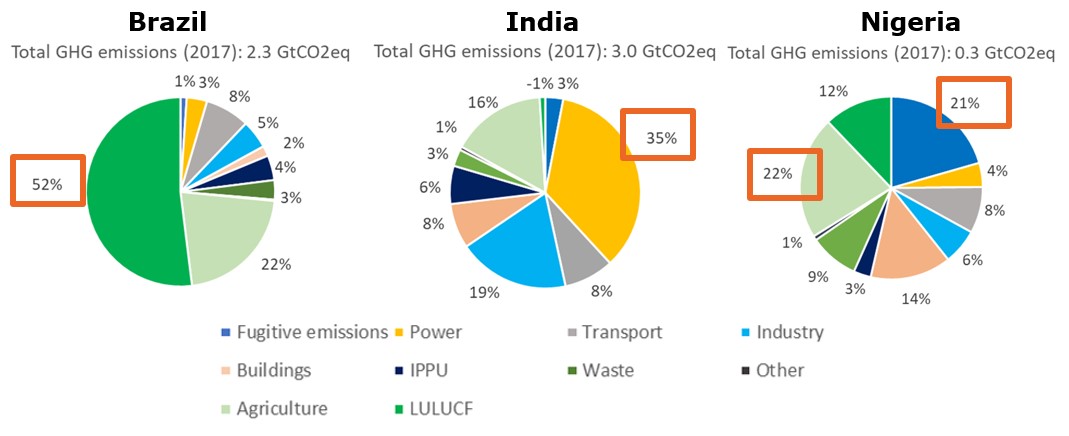
Source: Enerdata based on EDGAR, FAO, PIK/PRIMAP
Case study- Bangladesh and the challenge of aligning NDC priorities with a fast-changing environment
Bangladesh is a country with limited emissions: it represents less than 0.5% of GHG global emissions, and its emissions level per inhabitant reached 1.1 tCO2eq/cap. vs 6.5 tCO2eq/cap. worldwide on average (Enerdata based on World Bank, FAO, PIK/PRIMAP,201). Energy needs have increased rapidly, driving strong growth in emissions, especially in the power sector (around +9%/y over 1990-2017).
Agriculture is the largest contributor to the national GHG emissions (25%), followed by power production (20%) and LULUCF (12%) and (Enerdata own’s calculation based on EDGAR, FAO, PIK/PRIMAP, 2017).
The country’s first NDC (2016) set an emissions reduction target of 5% (unconditional) and 15% (conditional) compared to a BAU (base year 2011). It also set detailed conditional sectoral targets for transport (-24%), power sector (-18%) and industry (-10%). It appears that first NDC priority measures are not aligned with country’s most emitting sectors: there is no mitigation target defined for agriculture, and the LULUCF sector is not covered by NDC. Moreover, the BAU approach shows here its limits as this scenario is based on optimistic growth and energy demand assumptions, so that the -15% target (compared to proposed BAU) would mean a threefold increase in total emissions over 2011-2030.
Since 2015 and the release of the first NDC, several new national and sectoral measures or policies have been implemented -among others, the Power Sector Master Plans 2016 which plans to reach 2.5 GW of renewable capacity in 2021, and 3.9 GW in 2041-. The consideration of this updated context and new analysis axes will be crucial for the robustness of a revised NDC. In December 2020, the country published an NDC interim update, taking into account the additional work on agriculture, forestry and other land use (AFOLU) and National Forest Inventory 2016-2019 as well as the Power Sector Master Plan and the National Solar Energy Roadmap 2021-2041.
Case study- South Africa and the challenge of transition for a highly coal-dependent country
South Africa ranks among the 20th most emissive country worldwide and ranks 3rd country with the highest CO2 intensity to GDP.
Main drivers of the country’s CO2 emissions from fuel combustion are the high GDP growth and a carbon-intensive energy consumption, which has been continuously increasing since 2016 and remains higher than 2000’s levels. South Africa is indeed highly dependent on coal: this energy still represents more than 70% of the primary energy mix (-2 points over 2000-2017), and 90% of the power mix. As of 2017, around 40% of the country’s GHG emissions arise from the power sector (Enerdata own’s calculation based on EDGAR, FAO, PIK/PRIMAP).
The South African first NDC targets a complete decarbonisation of the power sector by 2050. Past trend shows rather an increase in the emissions factor of electricity production: around 855 gCO2/kWh in 1990, and 915 gCO2/kWh in 2017. The Integrated Resource Plan (IRP2019) plans the addition of 16 GW of wind and solar by 2030 (i.e. 26% of the power mix), while reducing the share of coal to less than 50%. Nuclear option has been removed. Targeting the NDC goal will require an ambitious acceleration in coal progressive phase-out, but is in line with the past trend (-16 points for the share of coal within 30 years).
COP-26: new ambitions towards a decarbonised world are still to be reflected in updated NDCs, Non-Annex I countries are on the front to realise the +2°C goal
COP-26: where do we stand?
As of April 2021, 76 Parties representing 1/3 of global GHG emissions have communicated a new or updated NDC, of which 43 Non-Annex I countries. Almost all Parties have updated the basis for defining their targets (reference points or BAU scenarios), which leads to higher-quality NDCs. 4 of the top 6 Non-Annex I emitters have currently officially submitted or proposed updated NDC:
Russia and Brazil submitted revised NDC but without increased ambition. Indonesia plans to submit a new target, however based on current policies, which should therefore not lead to a more ambitious target. China announced in September 2020 its willingness to reach carbon-neutrality by 2060. However, this commitment has not yet been officially reflected in NDC’s 2030 targets and this target is therefore currently indicative. India and Iran have so far not communicated any revised document.
Figure 6: Status of the 2020 NDC update target, worldwide
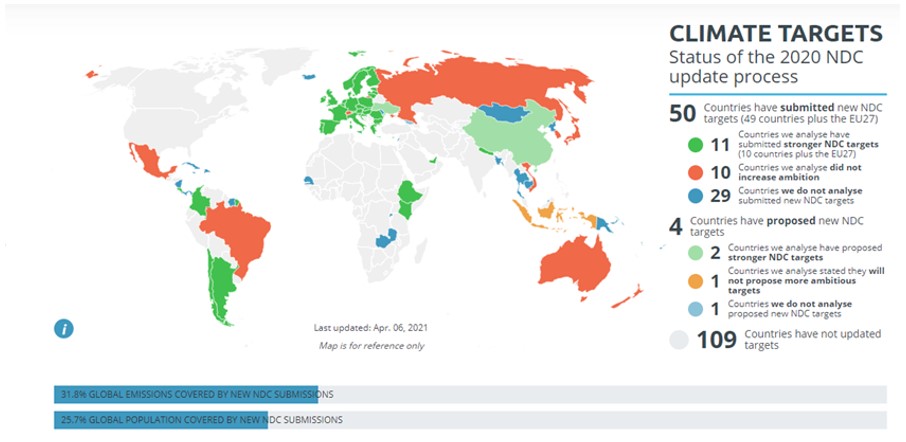
Source: Climate Target Update Tracker
Updated ambitions remain too limited to reach the +2°C target
According to the UNFCCC, the combined efforts in updated NDCs (as of end 2020, incl. Non-Annex I and Annex I countries) result in a less than 1% GHG reduction by 2030 compared to 2010 emissions levels… when reaching the 1.5 °C goal require global net anthropogenic CO2 emissions to decline by about 45% from the 2010 level by 2030 and reaching net zero around 2050.
Until 2030, the FAO estimates that GHG emissions from Agriculture in Non-Annex I countries will continue to increase (+0.7% over 2017-2030). There are hardly no estimates of LULUCF emissions linked to detailed scenarios, but in order to meet the Paris agreement, they should tend to reach zero or negative levels.
According to Enerdata’s latest emissions scenarios, the transition from a scenario based on current efforts (EnerBlue) towards a scenario compatible with the +2°C global goal (EnerGreen) will require a significative reduction from CO2 from fuel combustion activities and industrial processes, of which more than 70% will have to be realised in Non-Annex I countries.
On the long-term, China would bear around 1/3 of cumulated CO2 reduction efforts over 2019-2050 on its shoulders, followed by India (more than 10%). The role of smaller GHG Non-Annex I emitters together is significant with about 29% of the efforts to be made: this is more than total Annex I efforts required. Stronger attention and support to these countries’ in planning their commitments may therefore enable a strong impulse towards our common goal.
Figure 7: Future GHG emissions pathways in Annex-I and Non-Annex I countries
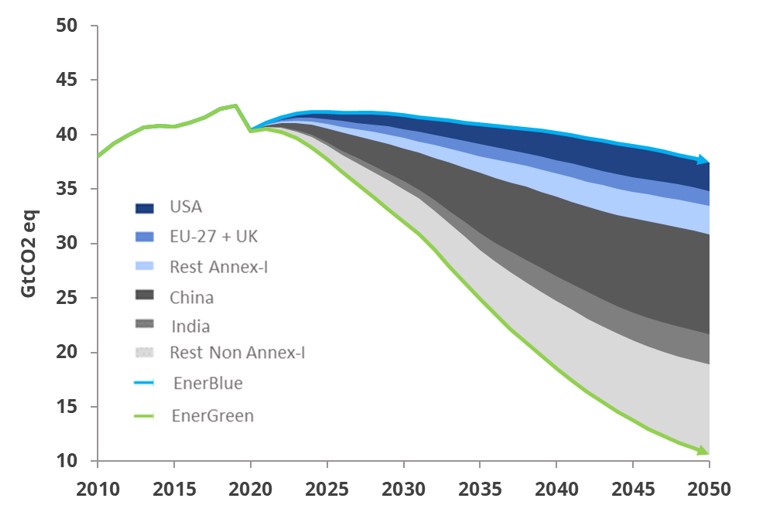
Source: Enerdata, EnerFuture Edition 2021
Key take-aways
- 6 out of 10 top GHG emitters are Non -Annex I countries and contribute to 43% of GHG global emissions, especially China with 26%. This has increased from 30% in 2000 (13% for China).
- Non-Annex I countries have to face several key issues to face climate change in terms of mitigation:
- the decoupling of economic growth and energy/ emissions as these countries still rely heavily on carbon-intensive energies
- the decarbonisation of power sector, which is still heavily based on coal (48% of the production mix in Non-Annex I countries as of 2019)
- the share of LULUCF and agriculture in their GHG emissions is significant: about 1/3 (excl. China). At the Non-Annex I level, the LULUCF sector does not play the role of carbon sink anymore.
- Yet a wide diversity of contexts and challenges exists among the different Non-Annex I countries, which have to be translated in differentiated objectives and policies.
- Transition towards a “+2°compatible” world will largely be based on the ability of Non-Annex I countries to reduce their emissions significantly: more than 70% of cumulated efforts as regards mitigation of CO2 emissions from fuel combustion and industrial processes should arise from these countries over 2019-2050, with a huge share on China (30%). Stronger attention and support to Non-Annex I countries in defining renewed NDC targets and aligning them with national policies should therefore be at the centre of the fight against climate change and discussions at the next COP.
Annex: Glossary of used acronyms and definitions
COP: Conferences of the Parties. The COP is the decision-making body of the United Nations Framework Convention on Climate Change. It is made of all States that are Parties to the Convention. A key task for the COP is to review the national communications and emission inventories submitted by Parties, and to assess the effects of the measures taken by Parties and the progress made in achieving the ultimate objective of the Convention. The COP meets every year, unless the Parties decide otherwise. The first COP meeting was held in Germany in March 1995, the next COP (COP-26) should take place in November 2021 in the UK.
GHG emissions: Greenhouse gas emissions. Main Greenhouse Gases are Carbon dioxide (CO2), Methane (CH4), Nitrous oxide (N2O) and Fluorinated gases (F-gases, incl. hydrofluorocarbons, perfluorocarbons, sulfur hexafluoride and nitrogen trifluoride).
LULUCF: Land Use, Land-Use Change and Forestry.
NDC: Nationally Determined Contributions are the non-binding national plans highlighting climate actions, including climate related targets, policies and measures that Parties commit to implement to achieve the global targets set out in the Paris Agreement in response to climate change.
Non-Annex-I countries: Non-Annex I countries are the Parties to the United Nations Framework Convention on Climate Change classified as “developing” countries (most of which are low-income economies), as opposed to Annex-I parties defined as “industrialized (developed) countries and "economies in transition”. Under the Kyoto Protocol, Non-Annex I countries do not have legally binding emissions reductions targets. Under the Paris agreement, the same reporting processes apply to all Annex-I and Non-Annex I countries, but developing countries are recognized as being especially vulnerable to the adverse impacts of climate change the Agreement aims at specific support to the special needs and concerns of these countries such as investment, capacity building and technology transfer.
The list of Non-Annex I countries is available under: https://unfccc.int/process/parties-non-party-stakeholders/parties-convention-and-observer-states?field_national_communications_target_id%5B514%5D=514
UNFCCC: United Nations Framework Convention on Climate Change, which refers to the international environmental treaty held in Rio de Janeiro in 1992 where the worldwide objective to "stabilize greenhouse gas concentrations in the atmosphere at a level that would prevent dangerous anthropogenic interference with the climate system" was adopted.
Notes:
1 Non-Annex I countries are the Parties to the United Nations Framework Convention on Climate Change classified as “developing” countries, for more details see Annex of this document.
2 Land Use, Land-Use Change and Forestry.
 Energy and Climate Databases
Energy and Climate Databases Market Analysis
Market Analysis